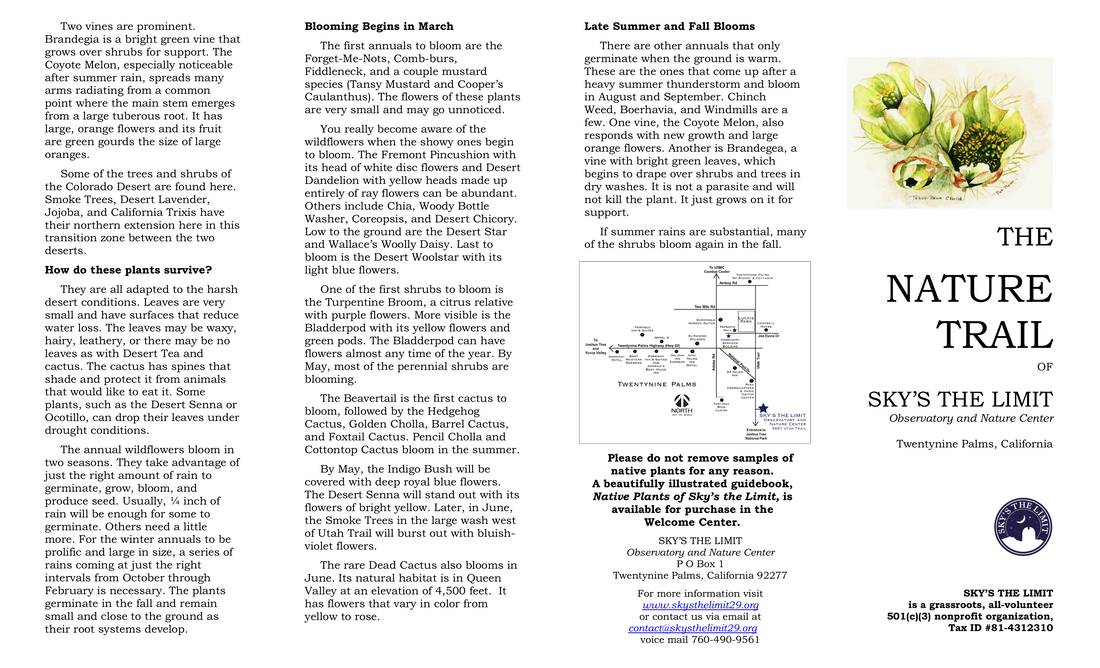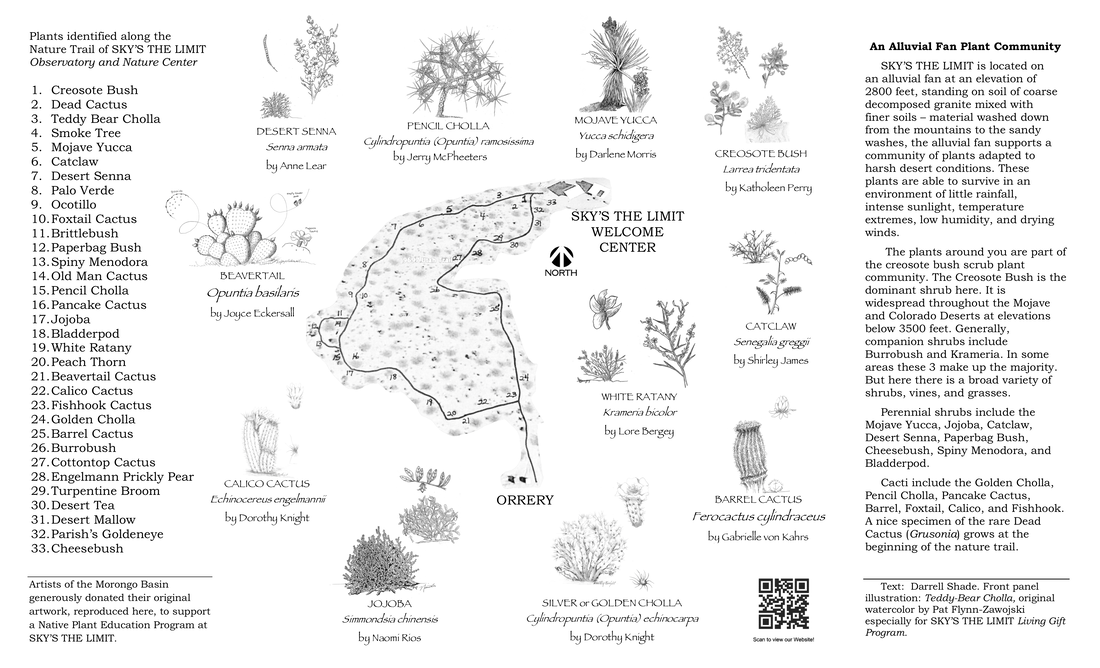- Home
- NIGHT SKY FESTIVAL
- Calendar
- SPECIAL EVENTS
- PLAN YOUR TRIP
-
OUR CAMPUS
- Tour Our Campus
-
Education Programs
>
- History of Astronomy
- Orrery >
- Meditation Garden >
-
Nature Trail
>
- Barrel Cactus
- Beavertail Cactus
- Bladderpod
- Brittlebush
- Burrobush
- Calico Cactus
- Catclaw
- Cheesebush
- Chuckwalla Cholla
- Cottontop Cactus
- Creosote Bush
- Dead Cactus
- Desert Mallow
- Desert Senna
- Desert Tea
- Engelmann Prickly Pear
- Fishhook Cactus
- Foxtail Cactus
- Golden Cholla
- Jojoba
- Mojave Yucca
- Ocotillo
- Old Man Cactus
- Palo Verde
- Pancake Cactus
- Paperbag Bush
- Parish's Goldeneye
- Peach Thorn
- Pencil Cholla
- Smoke Tree
- Spiny Menodora
- Teddy Bear Cholla
- Turpentine Broom
- White Ratany
- The Solar System and Beyond
- Solar Calendar/Sundial
- Ancient Astronomers
- STL Dome
- Sculptures on Our Campus
- ABOUT US
- SUPPORT US
|
|
NATIVE DESERT PLANTS ON THE NATURE TRAILSKY’S THE LIMIT is located on an alluvial fan at an elevation of 2800 feet, standing on soil of coarse decomposed granite mixed with finer soils – material washed down from the mountains to the sandy washes. The alluvial fan supports a community of plants adapted to harsh desert conditions. These plants are able to survive in an environment of little rainfall, intense sunlight, temperature extremes, low humidity, and drying winds.
|
Far from being a boring collection of similar, nondescript plants, the Nature Trail showcases 33 annuals, perennials, and cacti – each uniquely adapted to the desert environment, each singularly beautiful. You are welcome to print this brochure, which includes information and a key to the plants along the trail.
WHERE DID OUR DESERT PLANTS COME FROM?Twenty million years ago our deserts were covered with live oak, laurel, and palm woodland, and the climate was cooler and wetter with abundant summer rain. By 15 million years ago summer rain was occurring less often, and dryer, warmer conditions were prevailing; the climate was changing. Three to five million years ago the mountains of California were beginning to rise, creating the rain shadow that would eventually help create the desert conditions we find today.
As our deserts slowly became dryer and hotter, plants that had already adapted to arid conditions gradually “migrated” north from warmer southern areas by means of seed dispersal. Regular visitors to our plants will be able to observe the mechanism of dispersal as wind blows seed away from its parent, or a sudden rain carries mature seed down slope into a wash where the water-softened kernel may sprout. Birds, rodents, and reptiles eat the fruits, seeds survive their digestive systems and are deposited a distance from their source in another migratory step. Many seeds are gathered in hoards by rodents, some escape being eaten and ultimately sprout. Other seeds have prickly burrs or spikes which allow them to hitchhike to their new home on a bird’s feather, mammal’s fur, or hiker’s sock. About 1.5 million years ago Earth began to experience cold periods called “ice ages.” The exact cause is not known, but probably has something to do with Earth’s orbital variances with the Sun. There have been about 20 such cold periods; the last began about 20,000 years ago. During each cold cycle desert plants have migrated south only to reappear in our desert again during warm periods. Our desert as it appears today has been here since about 8,500 years ago, 1,000 years after the most recent warm period began. Earth is expected to experience an ice age again in about 10,000 years. |
Click on a plant name for a description and photo:
Barrel Cactus Beavertail Cactus Bladderpod Brittlebush Burrobush Calico Cactus Catclaw Cheesebush Cottontop Cactus Creosote Bush Dead Cactus Desert Mallow Desert Senna Desert Tea Engelmann Prickly Pear Fishhook Cactus Foxtail Cactus Golden Cholla Jojoba Mojave Yucca Ocotillo Old Man Cactus Palo Verde Pancake Cactus Paperbag Bush Peach Thorn Pencil Cholla Smoke Tree Spiny Menodora Teddy Bear Cholla Turpentine Broom White Ratany |
|
Observatory and Nature Center
9697 Utah Trail P. O. Box 1 Twentynine Palms, California 92277 760-490-9561 A 501(c)(3) nonprofit organization EIN 81-4312310 |
|
- Home
- NIGHT SKY FESTIVAL
- Calendar
- SPECIAL EVENTS
- PLAN YOUR TRIP
-
OUR CAMPUS
- Tour Our Campus
-
Education Programs
>
- History of Astronomy
- Orrery >
- Meditation Garden >
-
Nature Trail
>
- Barrel Cactus
- Beavertail Cactus
- Bladderpod
- Brittlebush
- Burrobush
- Calico Cactus
- Catclaw
- Cheesebush
- Chuckwalla Cholla
- Cottontop Cactus
- Creosote Bush
- Dead Cactus
- Desert Mallow
- Desert Senna
- Desert Tea
- Engelmann Prickly Pear
- Fishhook Cactus
- Foxtail Cactus
- Golden Cholla
- Jojoba
- Mojave Yucca
- Ocotillo
- Old Man Cactus
- Palo Verde
- Pancake Cactus
- Paperbag Bush
- Parish's Goldeneye
- Peach Thorn
- Pencil Cholla
- Smoke Tree
- Spiny Menodora
- Teddy Bear Cholla
- Turpentine Broom
- White Ratany
- The Solar System and Beyond
- Solar Calendar/Sundial
- Ancient Astronomers
- STL Dome
- Sculptures on Our Campus
- ABOUT US
- SUPPORT US



